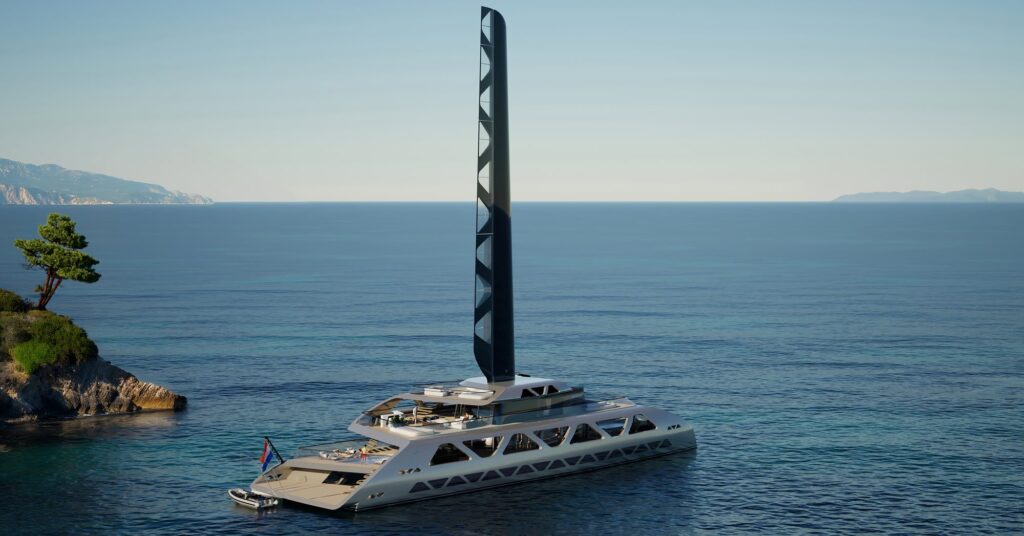Superyacht catamaran by Huisman
We previously wrote about the use of multi-hull ships as a solution to reduce emissions. After the French and the Italians, the Dutch yard Huisman is plunging into this promising development.
Mechanical sails are advancing in commercial shipping, in superyachts it is just a matter of time, thinks Dutch Royal Huisman. This week, the yacht builder, known for its sailing superyachts, presented its AERA concept. That yacht is best described as a 50-metre superyacht with a huge mechanical sail on the roof. Royal Huisman calls AERA ‘a realistic dream’.
Royal Huisman AERA
A super-efficient sailing yacht and a or motor yacht with enormous wind support in one. Pictures Royal Huisman
AERA combines an advanced Rondal wing sail with an efficient DC electric grid. The yacht has a retractable propulsion system, Rondal captive-mooring winches, an energy storage system (compressed hydrogen, fuel cell and batteries), Rondal hydrogenerators, variable-speed generators, HVO biodiesel fuel tanks and laser exterior lighting.
Potential sailors of this sailing superyacht can be accommodated on several decks.
The result of the AERA collaboration is a totally new kind of superyacht in hybrid catamaran form, which you can look at in two ways: a super-efficient sailing yacht with automatic systems that make sailing easier or a motor yacht that gets massive wind support that makes emissions virtually zero. AERA is a yacht where you don’t have to choose between sail or engine, Royal Huisman argues. ‘You enjoy the flexibility and sensation of both.’
New technologies on board.
Several years of work have gone into it with sister company Rondal, designer Cor D. Rover and Artemis Technologies. In it, according to the yard, ‘a whole toolbox of pioneering technologies is being deployed’ to increase efficiency and reduce emissions. ‘A realistic dream,’ Jurjen van ‘t Verlaat of the builder from Vollenhove in Overijssel calls AERA. ‘It is a combination of all the technical developments we have been working on in recent years. Ready to apply and some already partly used in our yachts.’
‘After a few months of exchanging ideas, we were convinced that a catamaran was the perfect platform: both because of the psychological approach of a fixed-wing sail and the inherent stability of a cat under sail. And on top of that, you get phenomenal decks,’ says Cor D. Rover.
Rotating wing sail
The adjustable-flap wing sail developed by Artemis Technologies is more powerful and at the same time simpler, quieter and more user-friendly than traditional sails. It can rotate 360 degrees as well as fully unwind, while remaining upright. No additional sails are needed, no sheets, blocks, furlers or winches on deck, and no winch boxes taking up space below deck. Two electric motors around the mast column in the yacht turn the wing. Hydraulic cylinders control the adjustable flaps along the trailing edge to generate lift and propulsion, or completely neutralise the wing by bringing it in line with the wind.
Source: Schuttevaer, Kees-Jan Visser, Photo © Royal Huisman
More on multihulls:


